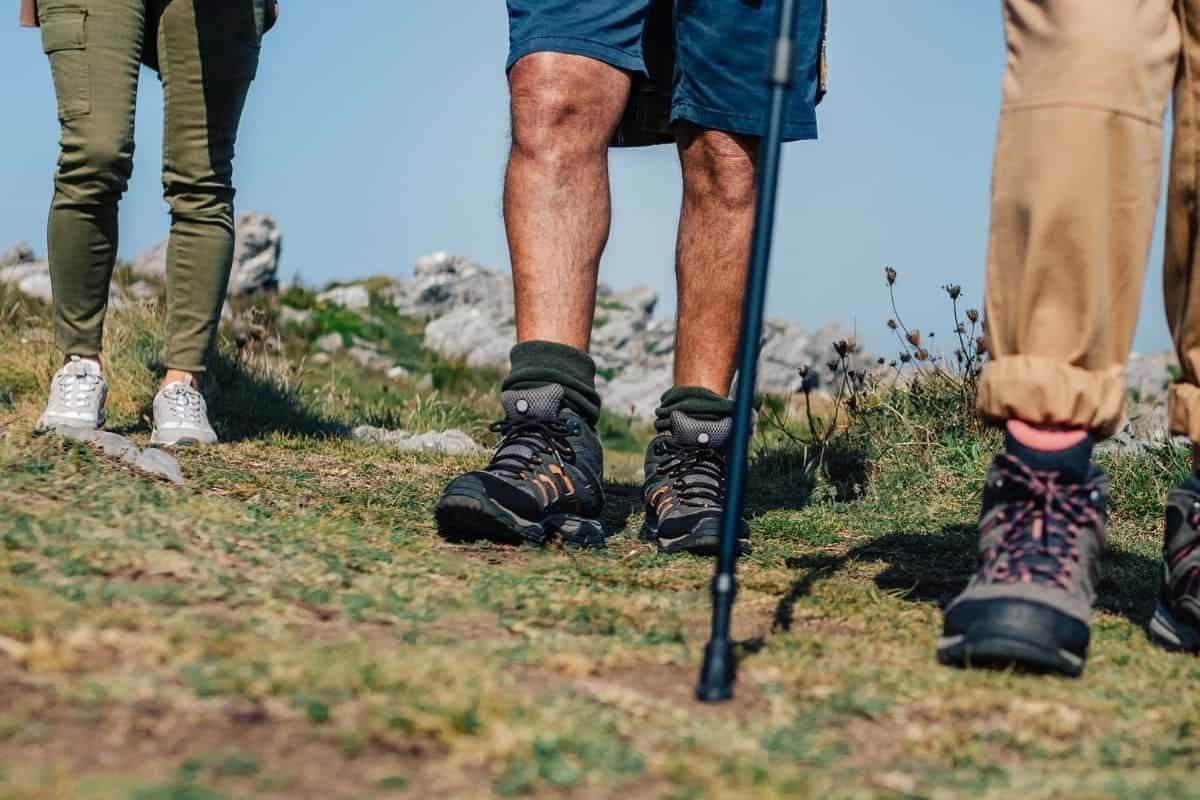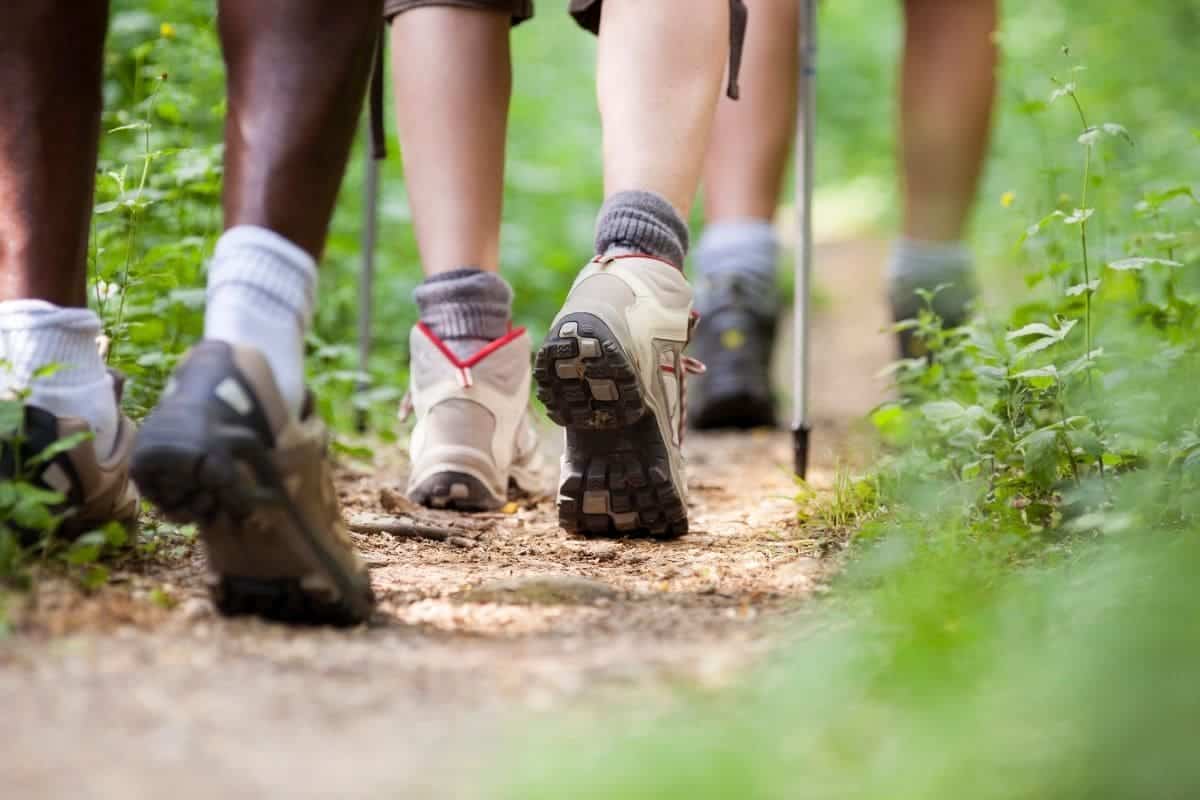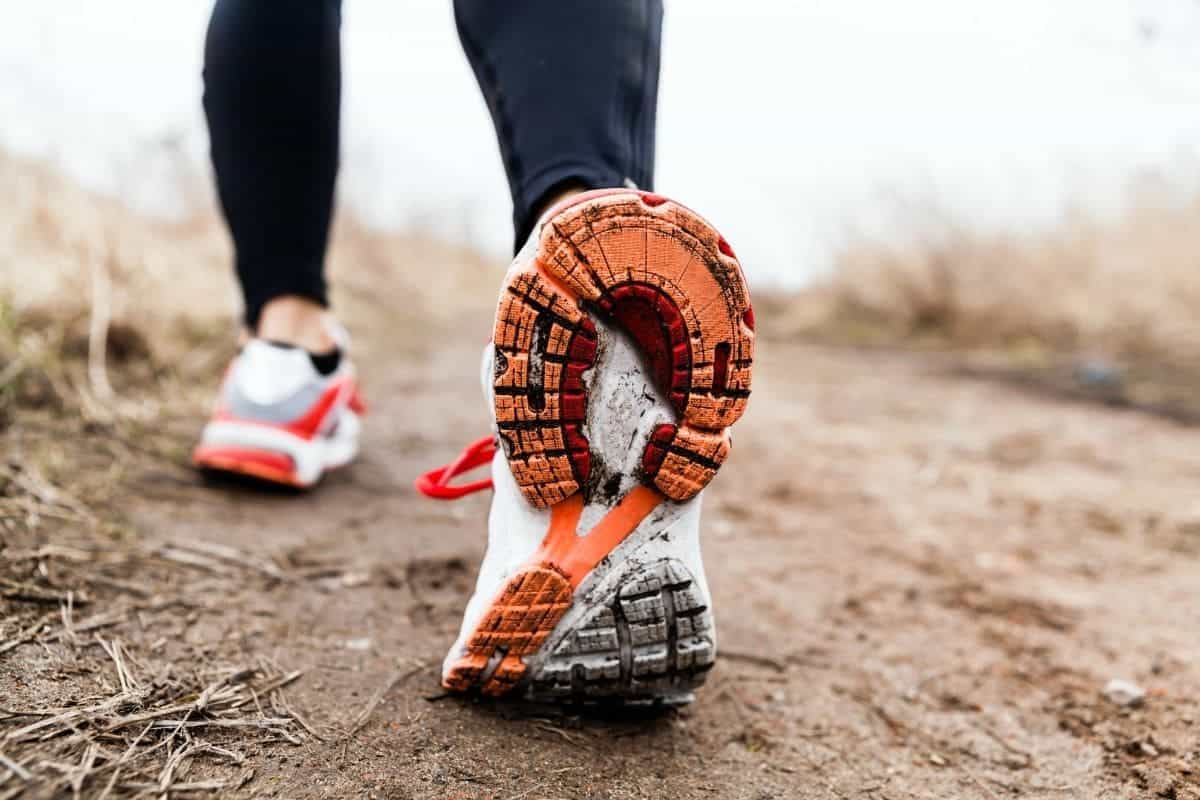Choosing the right footwear for hiking is essential for comfort and safety. Walking shoes offer lightweight, flexible soles for comfort on city streets or paths. Meanwhile, hiking shoes provide durability, water resistance, and sturdy soles for uneven trails.
The difference between the two will come down to specific features for the different demands of walking and hiking.
Key Takeaways:
- Walking shoes and hiking shoes are designed for different terrains and uses.
- Hiking shoes offer protection and durability for rough trails while walking shoes are lightweight for everyday use or light-day hikes.
What Are Walking Shoes and Hiking Shoes

In deciding between walking shoes and hiking shoes, I’m going to look at how each caters to its specific activity needs—from everyday casual walking to engaging in more adventurous outdoor activities.
Walking Shoes: An Overview
Walking shoes are my go-to for everyday wear or when I’m fitness walking. They are designed with comfort and flexibility in mind to cater to the natural stride of my walk. Here’s what I find important about walking shoes:
- Cushioning: Ideal for absorbing shock during a casual walk.
- Flexible Soles: They typically have thinner soles than hiking shoes, making them versatile for fitness or casual walking.
- Lower Ankle Cut: This design provides a more comfortable fit, which means they’re great if I’m wearing them all day.
Hiking Shoes: An Overview
When I head outdoors for some hiking, I switch to hiking shoes because they offer extra protection and ankle support, essential for rugged terrains. These aren’t hiking boots! They are shoes designed for more comfort when on a light trail.
Hiking shoes blend the sturdiness of boots with the lightweight feel of running shoes. Here’s a brief breakdown of their features:
- Ankle Support: Higher cut around the ankle to provide stability on uneven paths.
- Stiffer Soles: The beefy soles keep your feet safe from sharp objects.
- Cushioned and Flexible Soles: Even though they’re stiffer than walking shoes, good hiking shoes still provide enough cushioning and flexibility for longer treks.
- Traction: They offer better grip, which is helpful on slippery or uneven surfaces.
The Main Differences Between Walking Shoes and Hiking Shoes
When I’m choosing between walking shoes and hiking shoes, I think about where I’ll be trekking and what my feet will need. Let’s identify the details:
Material and Durability
I’ve noticed that hiking shoes are usually made from tougher materials like leather and might come with waterproof features like GoreTex – a lifesaver in wet weather. Walking shoes often favor breathable mesh to keep my feet cool but aren’t as durable with rocky trails.
Weight and Comfort Levels
Walking shoes win when it’s about keeping things light and comfy. They’ve got great cushioning and make it easier for me to walk further without my feet feeling heavy.
Hiking shoes, while they do provide more support, tend to be heavier. This is a trade-off for extra protection and performance on uneven ground. You’ll have to decide on the hike you’re doing, and what footwear you’ll need.
Sole and Traction
The sole game is where hiking shoes shine with their deep treads. This means they give killer grip when scrambling up slopes or tailbacks.
Walking shoes tend to have smoother tread patterns, which are perfect for sidewalks but not so much for slippery rocks.
Understanding Hiking Terrain and Footwear Demands

When I hit the trails, I know I’m facing a combination of rough terrain and unpredictable weather. My shoes need to tackle sharp rocks and muddy paths alike. At the same time, they are adaptable to sudden showers or a drop in temperature.
Trail Hazards and Footwear Protection
Hiking through uneven terrain teems with potential hazards; we’ve all been there. It’s not just about comfort; it’s about protection.
My hiking shoes have durable soles with deep lugs to grip the earth and keep me stable on slippery slopes. The reinforced toe caps and thicker sides help a lot when I accidentally kick a stubborn rock or when I’m squeezing through narrow passages.
- Rocks and Roots: A thick, protective rand wraps around the shoe, fending off abrasions and offering me a buffer between my feet and the sharp edges I encounter.
- Uneven Paths: On shifting ground, my shoes’ stiff midsoles provide underfoot support, preventing my feet from twisting and keeping me grounded.
Weather Adaptations
I’ve learned that weather can change in the blink of an eye during hikes. How many times has it been clean, then all of a sudden it starts raining? This is why I always check if my footwear is up to the task. My preferred hiking shoes are usually waterproof or at the very least, water-resistant.
Here’s what I look out for:
- Waterproofing: For those sudden downpours or when I need to wade through a stream, I rely on shoes with a waterproof membrane. This keeps my feet dry, warding off blisters and discomfort.
- Breathability vs. Insulation: In warmer conditions, shoes with breathable fabric help prevent my feet from overheating. But in winter, I opt for insulated winter hiking boots that retain heat and offer extra traction for snowy trails. There’s no getting around this; sometimes you just need to wear hiking boots.
Specific Features of Walking and Hiking Shoes

Now, let’s take a closer look at cushioning, breathability, and stability in both walking and hiking shoes.
Cushioning and Support
Walking shoes typically have ample cushioning in the heel and a flexible midsole that returns energy to me as I walk. They’re made to provide support for continuous, repetitive strides on flat surfaces.
On the flip side, hiking shoes have enhanced cushioning and support with a firmer midsole to handle rocky, uneven terrain. These shoes often include additional ankle support and a reinforced heel area to reduce impact stress on steeper inclines.
CoreM Pro Tip: You should always consider the specific features of shoes that will affect your comfort and performance when picking out footwear for outdoor activities.
Breathability and Flexibility
My walking shoes usually have a lightweight construction with breathable upper materials, like mesh, that keep my feet well-ventilated.
- Mesh designs: This mesh design also adds to the shoe’s flexibility, making it easy to move quickly on paved paths.
Hiking shoes strike a balance between breathability and protection from the elements, often incorporating waterproof membranes.
- Waterproof: They’re a bit less flexible than walking shoes, which helps protect my feet from irregular and rough surfaces while maintaining good airflow.
Stability and Balance
Stability is critical, and walking shoes are designed with a flatter sole to keep me stable on paved and flat surfaces. The outsoles of walking shoes typically feature a pattern that’s optimized for grip on these terrains.
Hiking shoes, however, have a more aggressive tread pattern on the soles to provide balance and stability on slippery or loose surfaces.
Their design includes a more robust midsole that helps maintain balance when traversing over rocks, roots, and uneven ground.
Comparative Analysis

In my exploration, I’ll highlight how walking shoes and hiking shoes stack up against each other in different environments and discuss their value for money.
Walking vs Hiking Shoes in Various Settings
| Environment | Walking Shoes | Hiking Shoes |
|---|---|---|
| Flat Surfaces | Comfortable, light | Overbuilt, heavy |
| Outdoor Activities | Casual, less durable | Durable, protective |
| Uneven Ground | Less traction | Superior grip |
Pricing and Value for Money
Walking shoes are generally more affordable than hiking shoes. They strike a balance between cost and the features they offer for everyday use. I find them cost-effective for my daily activities.
However, their durability may be lower, hence they might wear out faster than hiking shoes, thus requiring more frequent replacements.
Conversely, hiking shoes are a bit of an investment. They tend to have a higher price point due to their robust construction.
CoreM Pro Tip: For value for money, we focus on longevity and versatility. A good pair of hiking shoes can be more cost-effective in the long run, especially if you often navigate rugged terrains.
Making the Right Choice for Your Needs

When I’m choosing between walking shoes and hiking shoes, I always consider the fit, specific features for my activities, and how I can switch between different shoes without sacrificing comfort or performance.
Assessing the Fit and Comfort
Fit is king. Ill-fitting shoes lead to blisters no matter the activity. I ensure my hiking shoes have enough room to wiggle my toes and accommodate swelling, which happens often on the trails.
For walking shoes, I look for a snug fit that supports my foot without pinching. I prefer shoes with ample cushioning to absorb the impact during my fitness walks.
Evaluating Features for Specific Activities
The versatility and breathability of trail shoes make them ideal for varied terrain, while walking shoes perform best on flat surfaces.
- Light climbing: If I’m hitting rugged trails or plan on some light climbing, trail runners or approach shoes are my go-tos for their grippy soles and sturdiness.
- Walk in the Park: But for a leisurely walk in the park or an urban setting, I keep it simple: a pair of lightweight walking boots or running shoes does the trick.
Considerations for Transitioning Between Shoes
CoreM Pro Tip: To maintain high performance and reduce the risk of injury, you can use separate shoes for walking and hiking. This ensures that each pair is specifically tailored to its activity, optimizing safety and functionality.
Lastly, I’ve found that switching between specific shoes tailored to my activities lets my feet adapt. It also prevents wear and tear on the shoes themselves. Hiking shoes are built tough, but not for the repetitive motion on pavement, and walking shoes often lack the protection I need off-road.
Frequently Asked Questions
Can I wear hiking shoes for everyday walking?
Yes, you can use hiking shoes for daily walks. They offer good traction and are durable. However, they are heavier than walking shoes and might not be as comfortable for casual, everyday use.
What distinguishes walking shoes from hiking shoes?
Walking shoes are usually lightweight with breathable mesh uppers, designed for flat surfaces. Hiking shoes, on the other hand, are built sturdier with deeper lugs for grip and often have waterproof features for rough terrain.
Are walking boots suitable for both hiking and everyday use?
Walking boots can be used for both activities, but they are optimized for casual walks on even ground. So, they might not provide the same level of protection and support for hiking on uneven terrains as hiking boots would.
When should I opt for hiking shoes over walking shoes?
You should choose hiking shoes when tackling trails or walking on uneven, rugged terrains, where the added grip, protection, and support become essential.
How do hiking shoes and running shoes vary?
Running shoes are designed to handle the repetitive motion of running and provide cushioning for impact, while hiking shoes are meant to protect my feet against rough terrain and provide stability and grip.
What type of footwear should I choose for regular walks?
For regular walks, especially on paved or flat surfaces, you should opt for walking shoes. They are generally more lightweight and offer more breathability than hiking shoes.
Wrapping Up – Wearing the Correct Shoes Will Help You Enjoy More Adventures
Overall, the choice between walking shoes and hiking shoes depends on the terrain and activity you plan to undertake. Choose hiking shoes if you require rugged construction, enhanced support, and superior traction for rough terrain.
Conversely, opt for walking shoes, which are ideal for everyday use due to their comfort and flexibility. Thus, the right pair of shoes not only contributes to your comfort and performance but also protects your feet, allowing you to enjoy your adventures to the fullest!








I own 6 pairs of HIKES. Absolutely love them. Are they same as Baresteps. They look same. Just had two more pair delivered an hour ago. Highly recommend